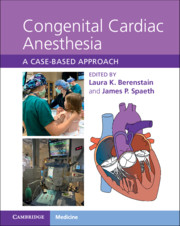Book contents
- Congenital Cardiac Anesthesia
- Congenital Cardiac Anesthesia
- Copyright page
- Dedication
- Contents
- Contributors
- Introduction
- Chapter 1 A Congenital Heart Disease Primer
- Section 1 Left-to-Right Shunts
- Chapter 2 Ventricular Septal Defect
- Chapter 3 Double-Outlet Right Ventricle
- Chapter 4 Transitional Atrioventricular Septal Defect
- Chapter 5 Unbalanced Atrioventricular Septal Defect
- Section 2 Right-Sided Obstructive Lesions
- Section 3 Left-Sided Obstructive Lesions
- Section 4 Complex Mixing Lesions
- Section 5 Single-Ventricle Physiology
- Section 6 Heart Failure, Mechanical Circulatory Support, and Transplantation
- Section 7 Miscellaneous Lesions and Syndromes
- Index
- References
Chapter 2 - Ventricular Septal Defect
from Section 1 - Left-to-Right Shunts
Published online by Cambridge University Press: 09 September 2021
- Congenital Cardiac Anesthesia
- Congenital Cardiac Anesthesia
- Copyright page
- Dedication
- Contents
- Contributors
- Introduction
- Chapter 1 A Congenital Heart Disease Primer
- Section 1 Left-to-Right Shunts
- Chapter 2 Ventricular Septal Defect
- Chapter 3 Double-Outlet Right Ventricle
- Chapter 4 Transitional Atrioventricular Septal Defect
- Chapter 5 Unbalanced Atrioventricular Septal Defect
- Section 2 Right-Sided Obstructive Lesions
- Section 3 Left-Sided Obstructive Lesions
- Section 4 Complex Mixing Lesions
- Section 5 Single-Ventricle Physiology
- Section 6 Heart Failure, Mechanical Circulatory Support, and Transplantation
- Section 7 Miscellaneous Lesions and Syndromes
- Index
- References
Summary
Ventricular septal defects are the most common congenital heart defect, occurring in 50% of patients with congenital heart disease. They may occur in isolation or be part of a constellation of complex cardiac defects. An isolated ventricular septal defect results in the ability to shunt blood between the left and right ventricles. The size of the defect and pulmonary vascular resistance determine blood flow across the defect. Timing for the surgical repair of a ventricular septal defect varies based on patient age and symptomatology as well as the size and location of the lesion, with most nonrestrictive defects closed within the first few years of life to avoid long-term pulmonary sequelae that can lead to eventual shunt reversal and Eisenmenger syndrome. This chapter discusses the implications of caring for a preterm infant with an unrepaired ventricular septal defect for non-cardiac surgery. An understanding of factors impacting pulmonary vascular resistance and systemic vascular resistance is vital to the anesthetic management of the patient with a large ventricular septal defect.
Keywords
- Type
- Chapter
- Information
- Congenital Cardiac AnesthesiaA Case-based Approach, pp. 9 - 13Publisher: Cambridge University PressPrint publication year: 2021

